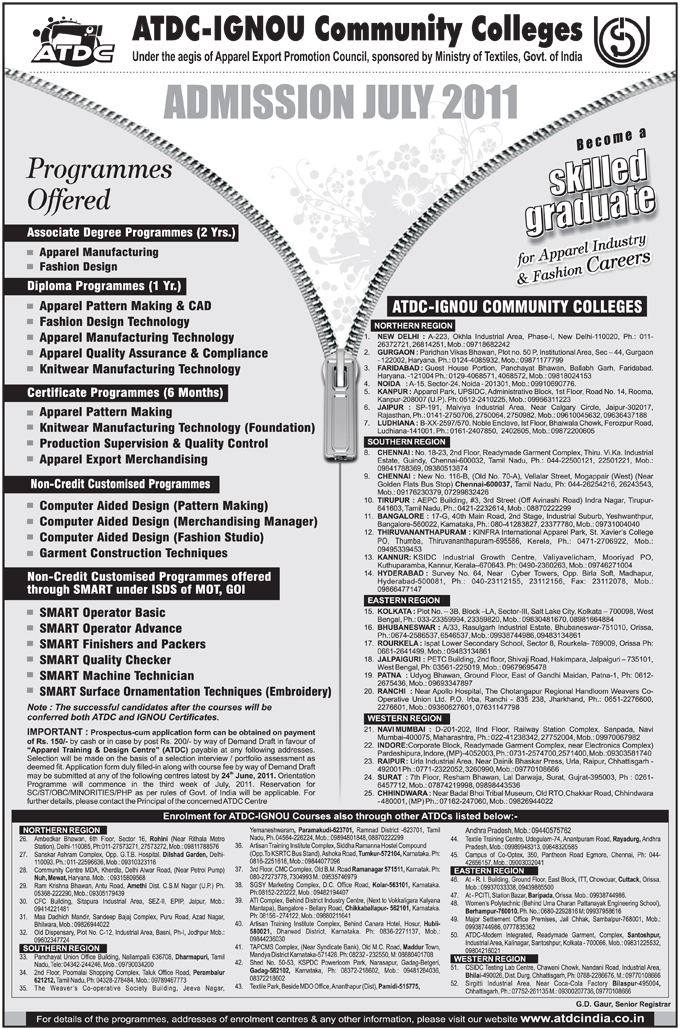Following is an excerpt from http://articles.economictimes.indiatimes.com/2011-07-08/news/29751942_1_universities-manipal-group-students.
Manipal Group is in active talks with Gujarat and Orissa governments for setting up universities in these states. This is part of group’s plan to have a footprint in all parts of the country. The chain plans to roll out five universities in next five years.
Manipal Group advisor – strategy and development – Sudhakar Rao told ET that all these universities would ideally come up across 200-300 acres each with a total investment of over Rs 6500 crores.
"We have identified Bangalore, Orissa, Gujarat, Haryana and National Capital Region (NCR) for the proposed universities. While land for Bangalore is finalised, we have initiated talks with Gujarat and Orissa governments for land and permissions. Other proposed universities are in conceptual stage," he said.
The Manipal group runs 200 courses including engineering, humanities, management, medicine and allied health sciences with four operational universities – Manipal University, Sikkim Manipal University, American University of Antigua and Manipal International University in Malaysia. Recently, the chain has launched its university in Jaipur which would be spread across 300 acres with an estimated investment of Rs 1200 crore over next five years.
… As per group’s plan, a university in Orissa will cater to the needs of students on eastern region, Gujarat university will cover the western region, Bangalore will absorb the spill over of southern region while NCR and Haryana universities will fulfill the educational needs of north and central regions.
"Each of these universities will be built to have 25,000 students on campus by its 10th year of operation. We also plan a university in Jharkhand. But it will come up in next phase," he said.
Odisha government should help them so that their Odisha plan happens smoothly. Any hurdles and they will focus on the other locations.
July 12th, 2011
The web page of Orissa Model Tribal Education Society (OMTES) is http://www.omtes.org. Following are excerpts from its "Background" page.
The Orissa Model Tribal Education Society (OMTES), a registered Society supported by the ST & SC Development Department, aims to make positive interventions in the field of tribal education. Since its inception in March 2000, it has been instrumental in setting up 11 Ekalabya Model Residential Schools in different parts of the State with assistance from Government of India. Besides that it also manages 19 Educational Complexes set up for providing education to ST Girls belonging to Primitive Tribal Groups. OMTES continues in its endeavour to serve the tribal population of the State by ensuring them to avail best opportunities in education at par with the non tribal population.
Following are some Q & A from its FAQ page.
How the schools are managed at the district level?
A school level management committee headed by the Collector of the respective districts, members including two educationist of the area looks after the overall development of the schools. Here the collector is the chairman and concerned Principal of ERMS is the Member Secretary.
I am a Tribal, what is the benefit the society has for me?
You benefit, when your child qualifies entrance of the school and receives free qualitative education. The society provides for improving the quality of tribal by promoting educational schemes for tribal community and improves the quality of life of tribal by Ashram Schools, Hostels for Tribal Boys Educational complexes, Post- Matric Scholarships and Book Bank Schemes, etc.
Whom do I contact for more information?
For information you are requested to contact ST & SC Development, Govt. of Orissa.
The 11 schools are listed in the page http://www.omtes.org/Yearwise_establishment_EMRS.html. They are in the districts of Koraput, Mayurbhanj, Sundergarh (3), Rayagada, Koenjhar, Gajapati, Kandhamal, Nabarangpur, and Jajpur.
The 19 educational complexes are listed in the page http://www.omtes.org/Yearwise_establishment.html. They are in the districts of Keonjhar (3), Rayagada (2), Nuapara, Mayurbhanj (2), Deogarh, Angul, Kalahandi, Ganjam, Gajapati (3), Malkangiri (2), Sundergarh and Kandhamala. Each of these complexes have a capacity of 250 making a total capacity of 4750.
In contrast, as of today, KISS has a student body of 15,083, which includes 3553 students pursuing +3. KISS had a student body of 1500 in 2005. I am sure the performance of the students is better at KISS than of the students at the OMTES schools and educational complexes.
So the Odisha government should just give land, seed money and grants to KISS and let them establish and manage much larger facilities in the districts with significant tribal students.
In http://www.kiss.ac.in/admission.html it is mentioned that every year KISS gets 30,000 to 40,000 applications per year for admission and admits between 2000-3000 of them. The government should fund KISS so that if not all who apply are admitted at least half of them are admitted.
It is a pity that other states have taken note of KISS and are inviting KISS to open replicas in their states while Odisha does not seem to be taking similar steps. Following is an excerpt from a report in Pioneer on other states approaching KISS for replicas.
A branch of the Kalinga Institute of Social Sciences (KISS) has been set up in Bastar, a tribal dominated and Maoist infested region of Chhattisgarh with assistance from the National Mineral Development Corporation (NMDC).
An MoU to this effect was signed between the KIIT and the KISS founder Dr Achyuta Samanta and NMDC director GB Joshi in the presence of the NMDC chairman cum managing director Rana Som at the the latter’s Corporate Office in Hyderabad on June 24.
As per the agreement, the NMDC has provided 30 acres of land along with all financial assistance to the KISS in order to set up its replica in Kankar region of north Bastar district in Chhattisgarh. In the first phase, 1000 tribal boys and girls will be admitted in this school. However, a total of 4,000 students from five districts in and around Bastar will get the opportunity of quality education here in course of time.
After Bastar, the Governments of Jharkhand, Madhya Pradesh and Delhi are keen to set up such model schools bearing all financial implications. They have requested Dr Samanta accordingly.
The page http://www.kiss.ac.in/fmngt.html explains how KISS is funded. The total amount there adds up to 18 crores. If 10 such KISS replicas are established in 10 tribal districts of Odisha at an additional cost of 200 crores/year, that will be the best use of such money for Odisha.
July 8th, 2011
(Thanks to Debi Sarangi for the pointer.)
The strategic plan is available at http://www.cable-quest.in/pdfs/StrategicPlan%20of%20I&B%20ministry.pdf. Following are some relevant excerpts.
(viii) INDIAN INSTITUTE OF MASS COMMUNICATION:
The Indian Institute of Mass Communication (IIMC) is an autonomous organization under the Ministry of Information & Broadcasting and a ‘Centre of Excellence’ in the field of communication teaching, training & research. The Institute was set up on August 17, 1965, as a department of the Ministry of Information & Broadcasting, Govt. of India in response to a need felt to evolve a methodology for effective use of communication resources as part of the country’s overall development strategy. The Institute was registered under the Societies Registration Act (XXI) of 1860 on 22nd January, 1966 and receives grant-in-aid from the Govt. of India through the Ministry of Information & Broadcasting to meet its recurring & non-recurring expenditure. While IIMC provides knowledge and skills to communicators in a variety of disciplines, including print, photography, radio & television, development communication, communication research, advertising & public relations, the Institute also collaborates with national & international agencies in conducting seminars, training, workshops, etc. It also undertakes joint research projects and organizes short- term courses to meet the specific needs of the industry, government and public sector organizations. The Institute presently have a branch at Dhenkanal in Orissa and propose to set up four new Regional Centres in the States of J&K, Kerala, Mizoram and Maharashtra.
(v) Indian Institute of Mass Communication (IIMC) (http://iimc.nic.in/)
Run courses with the objective to produce well-equipped communication professionals sensitive to needs of changing mass communication scenario; Conduct of short term specialized courses to meet the professional training needs of media personnel working in the Central/State Governments and Public Sector Organisations;
Conduct of seminars, symposia and conferences on various themes of communication with a view to contributing better understanding of communication in the context of India and other developing countries; Provide consultancy services on request to Central/State Government Departments and Public Sector Undertakings, in designing and organizing training and research programmes related to Development communication.
(a) The following steps needs to be taken –
1. First step
* Up-Gradation of One-Year PG Diploma Courses into Two-Year Advanced PG Diploma Courses.
* Seeking of Equivalence to Masters Degrees for the Two-Year PG Diploma Courses from Ministry of HRD.
* Introduction of at least 2 new Two-Year PGD Courses: in Development Journalism and in Corporate Communication & Media Management.
* Setting up of 4 new Branches ofIIMC in J&K, Mizoram, Maharashtra & Kerala.
2. Second step
* An Act of Parliament to declare IIMC an ‘Institute of National Importance’ such as the IITs, AIlMS, NIFT, etc., thereby also giving it Degree-granting powers.
* IIMC proposes to continue using its established and well-recognised Brand arne, as in the case of the above Institutes.
Upgradation of branches to full-fledged Institutes offering all Courses at par with IIMC, Delhi.
* Provision of Buildings, Infrastructure, and expansion or Technical Equipment and Human Resources at the 4 new Branches of IIMC (DPRs to be prepared after allocation of land by State Governments and in-principle approval of the Planning Commission).
* Dialogues with various State Governments for opening of new IIMC Branches in their States and pursuing them to allot at least 10-15 acres of land free of cost and also made available temporary accommodation for start of the courses from 2015-16.
3. Third Step
* Introduction of Specialized and Niche Courses (a) At least 2 new Two-Year PGD Courses
(i) Development Journalism
(ii) Corporate Communication and Media Management (b) More extensive Courses leading to better job prospects for students (c) Advanced academic programmes such as M.Phil and Doctoral Programmes (d) More Post Graduate MA, M.Phil. and Ph. D. Programmes
* Enhanced National and International recognition of IIMC and its programmes and enhanced interaction with the best international Universities and institutes in the field.
* Access to research and training funds from National and international funding bodies.
* Creation of IIMC Affiliates abroad.
* Correspondence with International Media Institutions/Government for opening of Centres in their Countries.
(b) Requirement of resources (i) Financial
* IIMC has already been sanctioned an outlay of Rs. 51.50 Crores for the activities mentioned in the first step as above
* Based on the current trend of requirements, provision of buildings, infrastructure and expansion of technical equipments for a branch for establishing a permanent campus will be approximately Rs. 100 Crores, excluding the cost of land, which would be provided by the State Governments free of cost ( Total Requirement for four branches will be Rs. 400 Cr)
* Financial requirement for the introduction of various Advanced Courses, M.A., M.Phil. and Ph.D. will be approximately Rs. 10 Crores
* Financial requirement for introduction of new branches in other States will be approximately Rs. 5 Crores in temporary accommodation to be provided by State Governments free of cost
Total Requirement : Rs. 415 Cr
(ii) Human Resources –
* 150 personnel will be required to achieve the activities detailed in the first steps
* Additional 25 personnel per branch will be required for fulfilling the activities given in the next steps
July 4th, 2011
The following table is extracted from http://jee.iitd.ac.in/openclose2011.php at two different times. The black version is after the first round and the red version is after the 3rd round.
| Institute |
Open EE (11) |
Close EE (11) |
Open ME (24) |
Close ME (24) |
Last rank |
| IIT Bombay (B) |
1
1
|
105
106
|
74
74
|
385
385
|
3615 (B44-Chemistry)
4182 (B44-Chemistry)
|
|
IIT Delhi (D)
|
43
43
|
205
207
|
228
228
|
564
574
|
3396 (D63-Biochem & Biotech)
3469 (D63)
|
| IIT Madras (M) |
131
131
|
380
380
|
327
327
|
771
771
|
3851 (M65-Biotech.)
3962 (M65)
|
| IIT Kanpur (K) |
45
45
|
537
556
|
246
246
|
839
840
|
4950 (K44-Chemistry)
5901 (K44)
|
| IIT Kharagpur (G) |
585
585
|
893
894
|
848
848
|
1083
1083
|
7426 (G39-Architecture)
7894 (G39)
|
| IIT Roorkee (R) |
814
814
|
1688
1709
|
1209
1209
|
1800
1806
|
8141 (R39-Architecture)
8964 (R39)
|
| IIT Guwahati (W) |
W16-1512
W16-1512
|
W16-2154
W16-2194
|
1725
1725
|
2443
2470
|
6556 (W38-Design)
6608 (W38)
|
| IIT Hyderabad (H) |
1943
1943
|
2736
2843
|
2274
2274
|
2922
3073
|
3478 (H07-Chemical)
3675 (H07)
|
| IT BHU (V) |
1844
1844
|
2945
2949
|
2514
2514
|
3155
3222
|
6811 (V40-Pharma)
7902 (V40)
|
| IIT Gandhinagar (N) |
2369
2369
|
3164
3164
|
2122
2122
|
3326
3455
|
3882 (N07-Chemical)
4076 (N07)
|
| IIT Bhubaneswar (A) |
3106
3134
|
3803
3822
|
3347
3347
|
4049
4147
|
4509 (A09-Civil)
4684 (A09)
|
| IIT Indore (U) |
3446
3446
|
3836
3879
|
3366
3366
|
3972
4092
|
3972 (U24-Mech)
4092 (U24)
|
| IIT Ropar (E) |
3017
3473
|
3859
3928
|
3441
3441
|
4025
4101
|
4025 (E24-Mech)
4101 (E24)
|
| IIT Rajasthan (J) |
3181
3530
|
3921
4127
|
3545
3545
|
4131
4280
|
5172 (J35-System Sc.)
5809 (J35)
|
| IIT Mandi (C) |
3786
3786
|
4318
4460
|
3965
4430
|
4415
4648
|
4415 (C24-Mech)
4648 (C24)
|
| IIT Patna (P) |
3659
3659
|
4400
4479
|
3324
3324
|
4474
4586
|
4474 (P24-Mech)
4586 (P24)
|
| ISMU Dhanbad (S) |
3380
3850
|
5027
5509
|
3357
3542
|
4932
5460
|
6746 (S44-Chemistry)
7785 (S44)
|
Among the new IITs the preference this year seems to be H > N >> {A, U, E} > J > {C,P}.
June 30th, 2011
Following is an excerpt from Shilpi Sampad’s report in Telegraph.
A university official said the sale of forms have soared this time as compared to previous years. Around 6,100 forms have already been sold at the two counters as against 7,000 last year. “We are expecting 2,000 more forms to come in. There has been an increase in sale of forms probably because more students are now opting for traditional and regular subjects,” the official said …
Following is an excerpt from a report in Times of India.
While there is just one applicant for statistics, which has 16 seats, there are very few aspirants for anthropology, food technology, bioinformatics electronics and home science.
Tripathy said there are very few colleges offering statistics at the graduation level. Hence, very few students want to pursue post-graduation in statistics. On the other hand, there are 66 applicants for 16 seats in MA or MSc mathematics.
The home science department this year has just four applicants for 16 seats. "This may be because the course had a new nomenclature this year. It was earlier called MA/MSc in home science. From this year, the varsity has changed it to MA/MSc home science (nutrition and human development) ," Tripathy said.
The varsity has got a record 250 applications for MSc Physics which has 24 seats. Some of these students will be given option to take admission in MSc electronics which has received around 10 applications for 20 seats.
The Sambalpur University Institute of Information Technology, which offers the bioinformatics and electronic courses, said students who have applied for MSc life sciences but failed to secure a seat will get a chance to take admission in MSc bioinformatics.
… Besides physics, departments of chemistry, English, sociology and political science also have received huge number of applications.
The varsity has got over 230 applications for 24 chemistry seats and 88 applications for 24 English seats. The varsity has got around 1800 applications this year for various PG courses compared to 1500 applications last session, varsity officials said.
June 29th, 2011
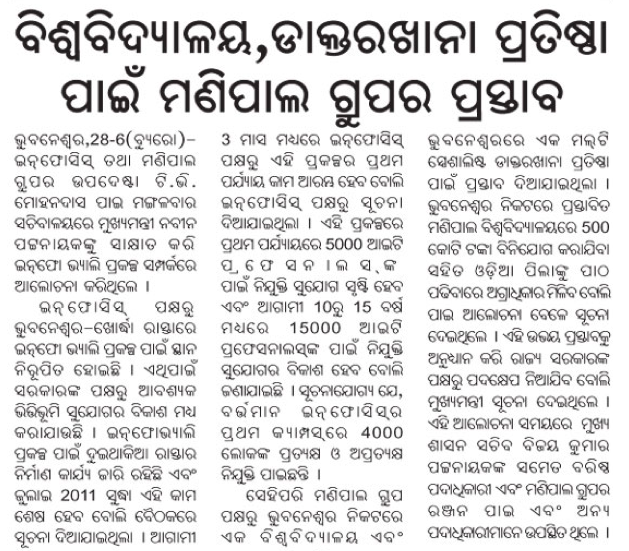
More information on Manipal can be found in http://en.wikipedia.org/wiki/Manipal and its official website at http://www.manipal.edu.
Among its various constituents the following have been ranked:
Some of its other salient features are (from its factsheet):
- Manipal has several international campuses including the Sikkim Manipal University. The other international campuses are in Malaysia, Nepal and Dubai.
- Over 300 courses offered across 14 professional streams in over 25 colleges
- India’s largest Foreign exchange earner in its category
- Over 1,20,000 students and 3,00,000 alumni from over 52 countries
- Established in 1953, Manipal University is the first educational Institution in private sector to become a deemed University; Over 20,000 students from over 52 countries
- Over 3000 practicing doctors in the US and every 4th doctor in Malaysia is an alumnus of
Manipal.
- SMU has two constituent institutes – Sikkim Manipal Institute of Medical Sciences (SMIMS) and Sikkim Manipal Institute of Technology (SMIT)
- Dubai Campus: Set up in September 2000 and is currently located in Dubai International Academic City; Has over 1400 students from over 20 countries, enrolled in its various specialized programs
Finally, Manipal is in the process of establishing Manipal International University in Jaipur. They are taking students from this year. Following is an excerpt from that page.
On invitation by Govt. of Rajasthan to Manipal Group, to start a multi-disciplinary Private University, Manipal International University, Jaipur, in the state comprising of courses in different disciplines like Engineering, Medical, Hospitality, Allied Health, Management, Communication, Jewellery Management etc.
… Allotment of 100 Acres of land at Dehmi Kalan Village near Jaipur in for the proposed campus.
June 29th, 2011
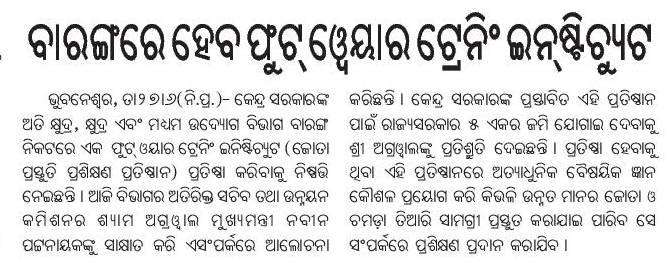 Currently MSME has two central footwear training institutes in Chennai and Agra. Their websites are:
Currently MSME has two central footwear training institutes in Chennai and Agra. Their websites are:
The Ministry of commerce also has similar institutes which are called Footwear design and development institute. The HQ is in NOIDA with campuses in Noida, Fusatganj, Chennai, Kolkata, Rohtak, Chhindwara & Jodhpur. The one in Jodhpur is a recent one; announce in March 2011.
While the Footwear training institutions focus on manufacturing the FDDIs focus on design and management. The former offers short term and diploma courses while the latter offers B.Sc and M.Sc programs.
June 28th, 2011
This year 162 degree colleges are participating in e-admission to their B.Sc/B.A/B.Com programs. Following are some numbers on this process from a Telegraph report.
After the announcement of Council of Higher Secondary Education (CHSE) or Plus Two results on May 30, students had applied to colleges of their choice online. Higher education officials said they had received a total of 74,968 application forms.
Around 48,019 candidates have been shortlisted according to the first selection merit list. …
In Bhubaneswar, BJB (Autonomous) College has increased the qualifying marks by one to five per cent in separate subjects for general students. In the arts stream, the cut-off mark for the general category was announced as 63.5 per cent as against 58.67 per cent last year. In commerce, it is 77.58 – an increase of over one per cent from the previous year. The science subjects, too, have seen a substantial rise. For physics-chemistry-mathematics (PCM) combination, it is 84.33 per cent, against last year’s 84.20 per cent, and in chemistry-botany-zoology (CBZ) combination, the cut-off is 80.33 per cent as against 78.5 per cent last year.
… Srilekha Ray, principal of Ramadevi Women’s (Autonomous) College here.
“We have raised the qualifying marks by over 10 ten er cent in PCM, around nine per cent in CBZ, seven per cent in arts and two per cent in commerce for the general category,” she said.
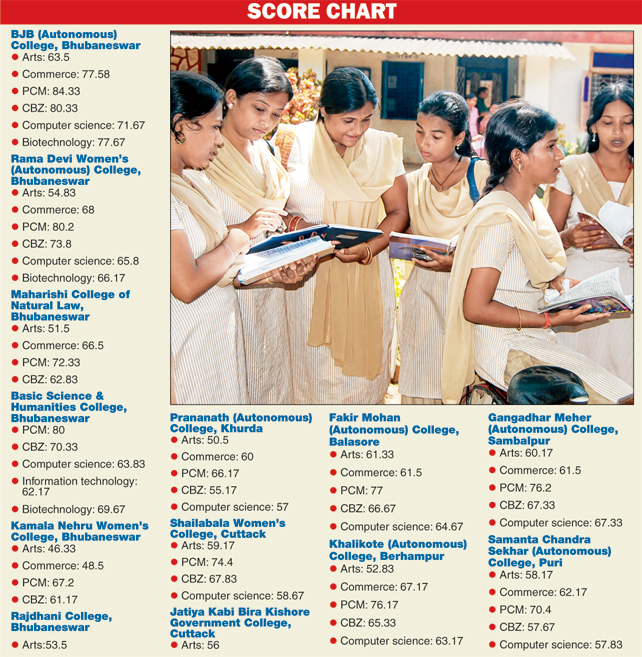
June 25th, 2011
Following are excerpts from Bibhuti Barik’s report in Telegraph.
… The master plan is ready and the Department of Atomic Energy (DAE) has selected Larsen and Toubro (L&T) to execute the job. They are expected to start the work next month. The project has to be completed within 36 months … We hope that the Phase-I work comprising four major schools and the administrative block will be over by the end of 2013,’’ said the institute’s registrar, AK Naik.
The campus is coming up on 298 acres near Jatni.
While the forest department has already marked 285 trees for felling top facilitate work, steps to ensure enough greenery are being taken by planting 2,500 saplings along its fenced boundary. “We are planning more afforestation programmes in future,” added Naik.
The project envisages an expenditure of Rs 457 crore in the first phase including Rs 160 core on residential township and Rs 130 crore on academic buildings and a sports complex. The Centre has sanctioned Rs 823.19 core for the entire campus project in Bhubaneswar.
After fencing the authorities have deployed a 25-member security team with a supervising officer to keep watch. … the NISER campus site is safe. A transformer has been installed at the site to ensure uninterrupted power supply. Two corrugated tin sheds have also been put up at the site for the engineers to work out of.
The Registrar added that the construction work was getting delayed as the approval of the one of a senior officials of the Ministry of Finance was still awaited. Once it was available the executing agency would go ahead with the work. Earlier there was some delay on account of the time taken by the department of atomic energy (DAE) to grant certain approvals.
“The DAE technical panel inspected, checked and approved each and every aspect of the engineering drawing which took one year,” said a senior professor, who is an advisor and member on the NISER Board.
Currently operating from a transit campus of 5,000 square metres within the Institute of Physics (IoP), Bhubaneswar premises, NISER has lab, teaching and research facilities. While Rs 12.5 crore has been spent on these facilities for the school of chemistry Rs 13.5 crore for the school of physics, Rs 25 crore for the school of biology and Rs 5 crore for the school of mathematics.
… “We have been promised a three-acre plot by the state government for setting up a city campus in future. This will include a 1,500 seated conference hall,” said the registrar.
June 24th, 2011
Following are excerpts from a report in ibnlive.com.
… The Ministry of Human Resource Development held a meeting with the representatives of IITs, including the eight new ones, in Delhi on Thursday.
… Like its counterparts, the Bhubaneswar institute too is behind the schedule and unlikely to meet its 2013 deadline given the existing pace of work. With problems of land acquisition and transfer, the IIT Bhubaneswar has been able to construct only boundary walls measuring about six km. …
Sources said that IIT Bhubaneswar would submit a report to the Ministry detailing its bottlenecks about land transfer, forest land conversion, acquisition of private land and infrastructure like road, power and water.
With the slow progress raising hackles, the IIT has decided to hasten establishment of its campus at Arugul, about 25 km from here. Works estimated at 30 crore will soon be taken up with two-phase tenders.
The first tender will be scheduled in July and include works such as roads inside the 935-acre campus, sewerage and site development. The second tender will be floated around December for construction of buildings.
… Most of the new IITs, sources said, sought that new project proposals be chalked out since the 12th Plan is only three quarters away and the project costs will stand revised at the current prices. The IIT Bhubaneswar was earmarked 760 crore, half of which is towards infrastructure.
The sources further said that each of the new institutions is likely to cost close to 1,400 crore for which funding proposals will have to be placed in the 12th Plan.
June 18th, 2011
Following are excerpts from the Economic Times article.
The IITs have completed 50 years and have helped build India. They were set up for producing high quality technical human capital for India and have met their objectives. But, as is the character with such institutions, they have not changed with the times and are not providing India with what she now needs.
… The IIT boards and the directors are unable to take any financial decision which they deem fit without the approval of the government . Even for an overseas travel of the director or the faculty, permission is needed. They are subject to austerity measures of the government, a perfect situation to emasculate an educational institution.
The demand for an IIT seat is enormous and has spawned a tutorial industry that earns more revenues than the IITs themselves. This has resulted in large number of students spending up to two years of their youth going to cramming schools learning pattern recognition, forgetting the art of thinking and problem solving knowing that their lives are made once they get entry into the hallowed portals. Today about 60% or more of the intake is from the coaching mandis. This has also resulted in many bright young Indians deciding not to undergo the ordeal and go overseas for higher education. 250,000 of them study overseas, over 110,000 in the United States, about 45,000 in the UK spending about $ 6bn on fees and costs annually …
Overall , the 15 IITs graduate 7000 undergraduates, 6000 post graduates and about 1700 PhDs annually . Sadly only about 2% of the undergraduates go on to their masters and PhD in the IIT system. The IITs hold fast to the idea that by squeezing input they can get a quality output, an idea that has been consigned to the dustbin of history. Increasing the scale and size can give them the diversity of talent, the resources, the ability to have more quality faculty and the depth and width needed for an elite educational institution.
… the IITs will live in their ivory tower and possibly become less and less relevant to India’s need as neither are they meeting India’s need for more human capital nor producing the kind of PhDs India needs.
… The best solution is to open up the education system and allow competition, the dreaded word in academics, to come forth. India should revise her educational policies and allow the private sector to set up "innovation universities" granting them all that they need. Full autonomy, academic, administrative and financial to chart their own future. Some safeguards are needed, as this is a public good. A large corpus of say Rs 100 crore, an open merit based admission policy, a faculty compensation policy based on minimum UGC scales and an assurance that they will aim to be amongst the top 100 in the world over the next 25 years. To ensure access to the merited we need a national scholarship scheme which will fund students. India needs to trust the genius of her citizens to create institutions that are world class and not look at them through myopic eyes with suspicion.
… Today there is a flight to quality. The bad colleges are dying since students have a choice, they are voting with their feet. The good ones are expanding and seeing greater demand. The market mechanism has worked, not by design but by serendipity. So there is hope. Look at various other sectors today. Bharti has made BSNL redundant and has given us a choice, Jet has overtaken Air India and given us a choice, the power system in Mumbai is still the best, and in education the Indian School of Business has turned our IIMs inside out. The IIMs actually want reform, expansion and are concerned about their future .
Competition and an open liberal environment for higher education will work .
I agree with most of the points made in the article and its arguments buttress the need for early approval of universities like the proposed Vedanta University.
One point where I disagree is the suggestion that 100 crores is a large corpus. If the goal is to be in the top 100 in the world, a corpus of 100 crores is very little. That is only 20-25 million USD. In comparison the corpus of Harvard and Stanford are of the order of 25+ Billion USD.
June 16th, 2011

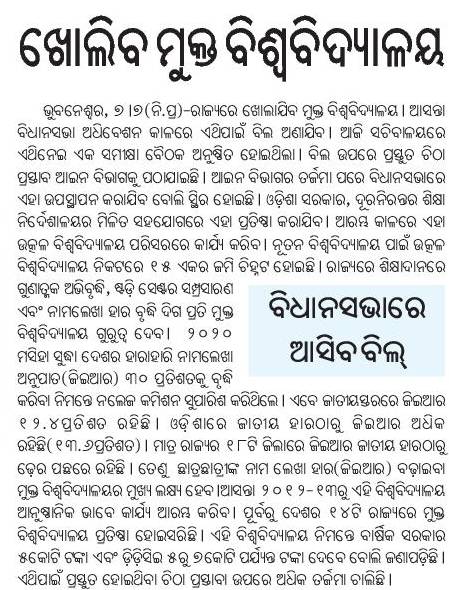
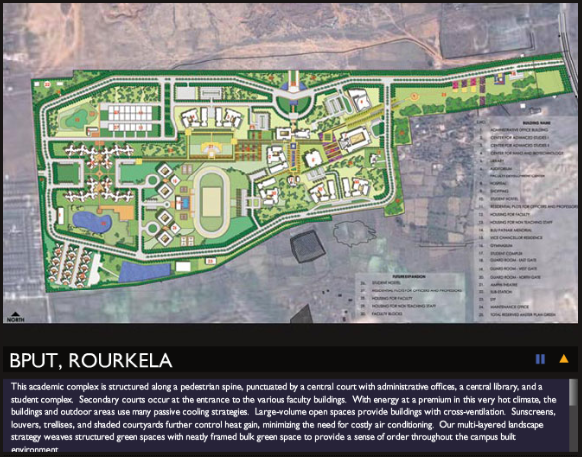
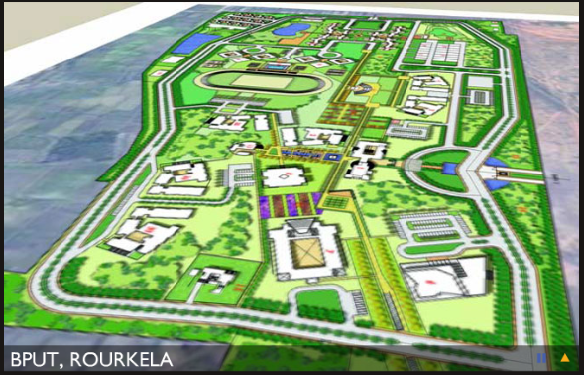
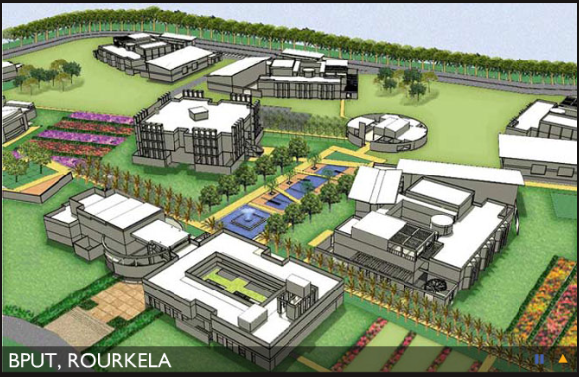
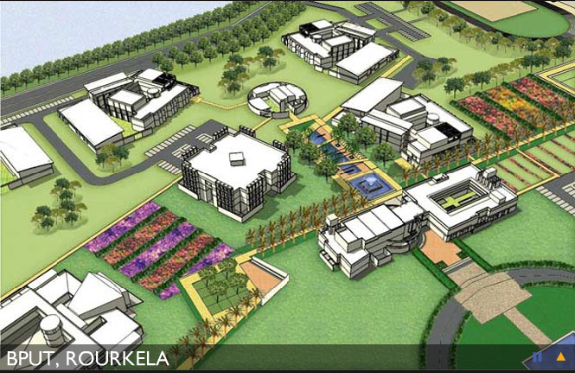
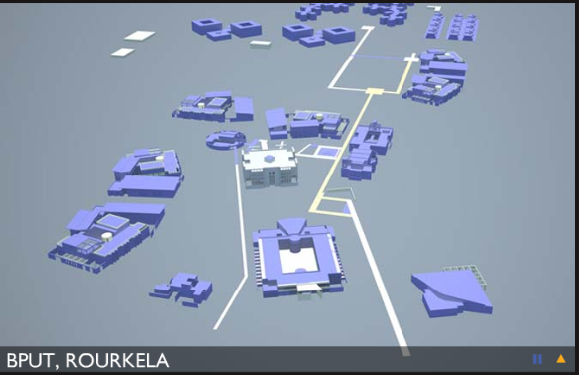
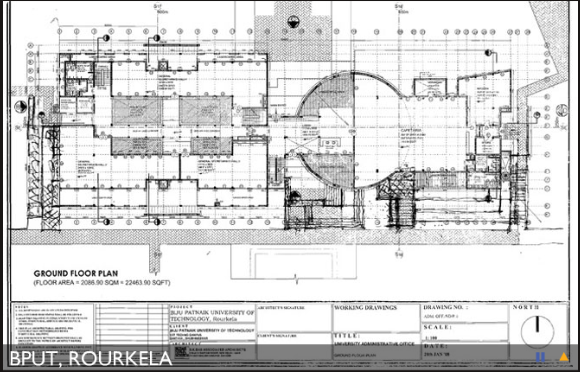
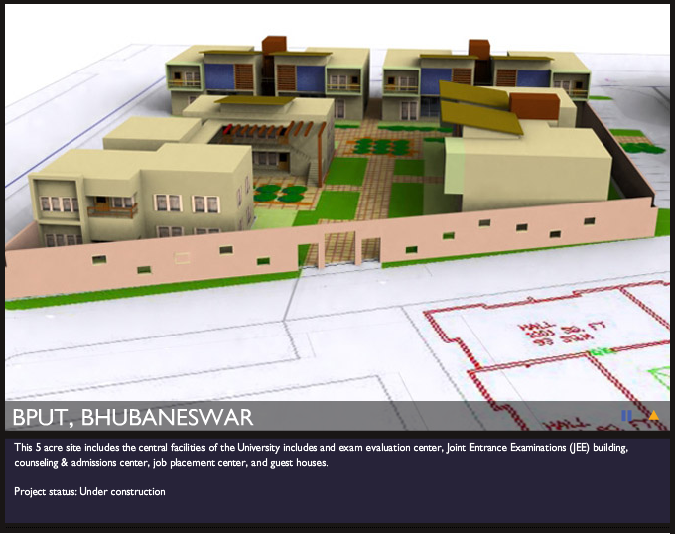
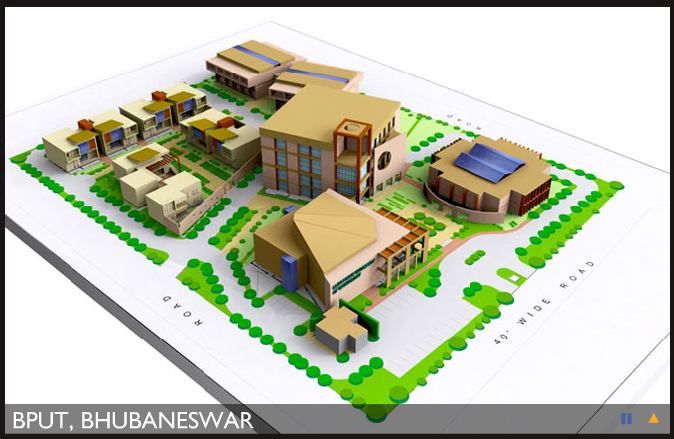
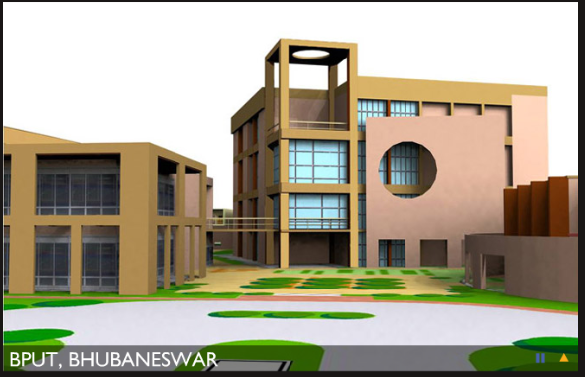
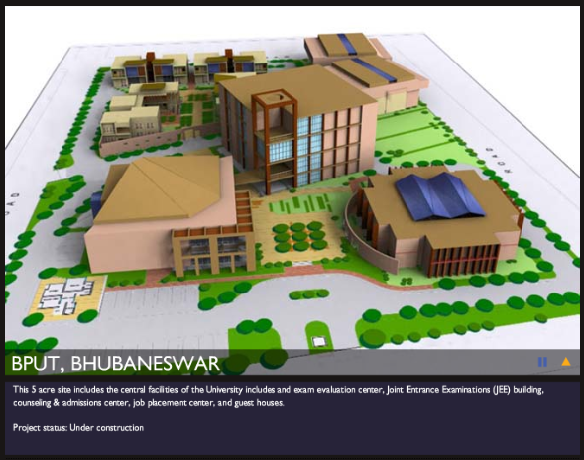
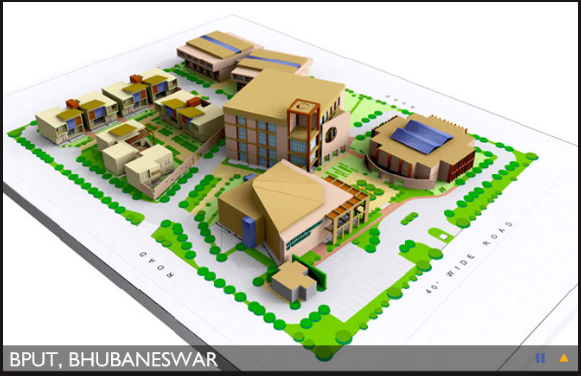
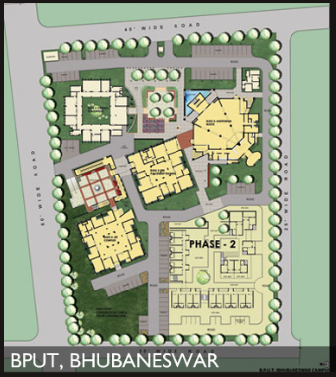

 Currently MSME has two central footwear training institutes in Chennai and Agra. Their websites are:
Currently MSME has two central footwear training institutes in Chennai and Agra. Their websites are:
